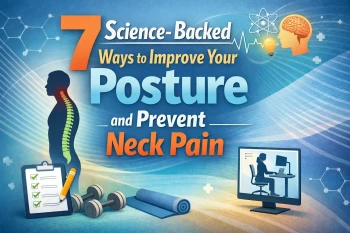
What is Trigeminal Neuralgia?
Trigeminal neuralgia, or tic douloureux, is a chronic neurological disorder. Before we move towards deeper and complicated details it is necessary to understand this disorder very clearly. As the name of this disorder suggests it concerns the fifth cranial nerve called the trigeminal nerve.
Due to a lesion or injury to CN V the function of this nerve is impaired. To understand the condition it is necessary to understand the route of CN V. this nerve is divided into three parts; ophthalmic, maxillary and mandibular division.
Ophthalmic branch innervates the orbital region, the maxillary branch innervates the region till the upper gum and the mandibular region innervates lower jaw, lower lip, and lower gum. Trigeminal neuralgia is characterized by sudden, sharp, stabbing pain in the jaw and surrounding region.
Usually, this searing pain lasts for merely 2 seconds but its duration can stretch for as long as 2 minutes. The electric shock-like pain in this disorder is prim targets the jaw, gums, and teeth. This disorder mainly occurs on one side of the face and that too only in the lower part.
Quite rarely, this condition affects both sides of the face. In that condition, it is called Bilateral Trigeminal Neuralgia. Initially, the duration and intensity of pain are short and mild but as the time period progresses the duration, frequency, and intensity of pain increase.
People affected by trigeminal neuralgia experience episodes of aching and throbbing pain for several days, weeks, and even months. There is a possibility of the pain to subside on its own for a few months or years but it usually makes a come-back. Shockingly, the pain experienced in trigeminal neuralgia is the most excruciating and intense pain known to humanity and medicine.
Trigeminal neuralgia has two types.
Type 1 TN: Type 1, also called classic and typical, trigeminal neuralgia involves sudden, stabbing, and electric shock-like pain in the lower part of the face. This pain lasts for a minimum of 2 seconds to a maximum of 1-2 minutes in each episode. In severe episodes, a stabbing pain jolts into the lower jaw for more than hundreds of times. When episodes form a quick series then the duration of pain stretches to 1-2 hours.
Type 2 TN: Type 2, also called atypical, trigeminal neuralgia does not involve episodes of jolting pain in the lower face. Instead, there is a continuous episode of dull, burning, and stabbing pain in the lower jaw.
Both types of trigeminal neuralgia can exist at the same time.
Trigeminal neuralgia is a non-nociceptive pain.
The term ‘nociceptive’ must be new or strange for you but it is strongly associated with trigeminal neuralgia. Basically, there are two types of pain; nociceptive and non-nociceptive. In the former, there must a trigger to initiate pain and stimulate the pain receptors in the body to sense the pain.
Every kind of pain we feel after burning, hitting, falling or any other act is an example of nociceptive pain. Now comes non-nociceptive pain. This type of pain does not require an external factor to initiate pain signals and stimulate the pain receptors.
Damage to the nerve due to lesion or damage stimulates the nerve to send signals of pain without any stimulus. That is why a person with trigeminal neuralgia experiences a sudden attack of pain. In fact, the term ‘neuralgia’ typically means non-nociceptive pain.
Who is at risk?
According to National Institute of Neurological Disorders and Stroke (NINDS), trigeminal neuralgia is more common in women as compared to men. Although it affects people of all age groups, still those people who are older than 50 are at risk.
Moreover, there is a genetic factor that influences the occurrence of this neuropathy. Since blood vessel characteristics are inherited from the family therefore it is likely to occur in the off-springs. Other risk factors include multiple sclerosis (MS) and hypertension.
What are the causes?
When we talk about how it happens we mention two things; causes and triggers. Brain lesions, tumor, genetics, surgical injuries, and physical injury to trigeminal nerve appear to be the main causes of trigeminal neuralgia.
However, more important to understand and acknowledge are the triggers. There are certain acts that put pressure on the nerve and pinch or compress the nerve. Triggers include shaving, washing face, touching the face, smiling, eating, drinking, feeling a breeze on the face, putting on makeup, talking, and brushing teeth.
These are not extraordinary acts but very simple acts from daily life.
What are the symptoms of Trigeminal Neuralgia?
- In trigeminal neuralgia, there are sudden episodes of severe stabbing pain in the lower part of the face mainly the lower jaw.
- These attacks of pain occur upon touching the face anyhow.
- Each episode of pain lasts for few seconds to few minutes. In worse cases, duration extends up to 1-2 hours.
- Before the episode of searing pain begins there is constant, dull aching pain for a few days, weeks, or months. Ultimately, the ache develops into a sudden jolt of pain.
How is it diagnosed?
There is not a specific or single test for the diagnosis of trigeminal neuralgia. Mostly, a doctor concludes this diagnosis by relying on history, clinical presentation, symptoms, and physical examination. They touch the face to determine the location of the pain.
They inquire about the intensity, frequency, and duration of pain. To confirm the diagnosis, they perform MRI. By screening, the possibility of multiple sclerosis can be ruled out.
Chiropractic care is the answer to it!
Upper cervical chiropractic is known to reduce the symptoms of trigeminal neuralgia. The trigeminal nerve originates from brainstem which lies exactly above the spinal cord. The first and second cervical vertebrae named Atlas and Axis when disturbed cause impairment in the function of CN V.
With gentle adjustments the cervical vertebrae are aligned which minimizes the symptoms. Chiropractic experts believe in their vast experience of providing relief to the patients who were in pain due to trigeminal neuralgia. This neuropathy causes disturbance in life and causes cognitive behaviors.




Leave a comment